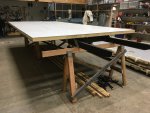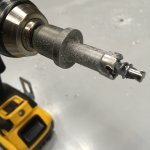Lowly Update:
With the subframe 95% welded up (there are some parts needing to be welded once they are located off of the truck's chassis) it was time to remove the deformation caused by the heat of the weld and subsequent shrinkage of the material. Once again utilizing the original subframe as a strongback, I used 12 ton bottle jacks to push up on the places needing straightening while holding down on either side using chain rated for 5400lb capacity.

Once the system was lightly loaded, I fired up my propane powered weed burning torch and heated up the metal above the jack I intended to bend. With it flesh sizzling hot, I then put the bottle jack to work and pushed up on the subframe past its straightened state (knowing there would be spring-back). I then used a towel soaked in cold water to repeatedly quench the heated area with the hope the steel would retain some of the torture it was being subjected to.

Once the entire area returned to ambient temperature I backed off the bottle jack to reveal if any progress had been made. It took a few times per side but the frame eventually straightened out to my liking.
A few things to note:
1) systems under tension like this should make your sphincter nearly turn itself into a localized black hole; if it doesn't then you aren't aware of the acute risk of bodily harm or death should something break under load
2) drapes such as a towel or jacket over the tensioned chains can go a long way toward dissipating or redirecting kinetic energy in high velocity chains
3) don't try and get all the results in one cycle, in one location (see below)
4) watch out that you don't brand yourself of the steel or give yourself steam burns when quenching
As for note #3 above, I did get too ambitious on one side and ended up cracking a weld on the c-channel rail where I had previously had to patch a wrongly located notch.

When it decided to let go, the entire frame/jack/chain/sawhorse system jumped due to the quickly relieved stress and there was a brief disturbance in the space/time continuum several inches below my tailbone (see note #1 above). Once I said a prayer of thanksgiving for being given the opportunity to keep on living I went about grinding, drilling, clamping and welding up the offending crack.

With the subframe finally straightened, I chopped up and removed the original subframe. Cleaned up the shop a little bit, resettled the new subframe on the sawhorses and got ready for the next phase of the project: introducing the habitat's floor panel to the subframe.

Three cheers for progress!
- Sheik




















